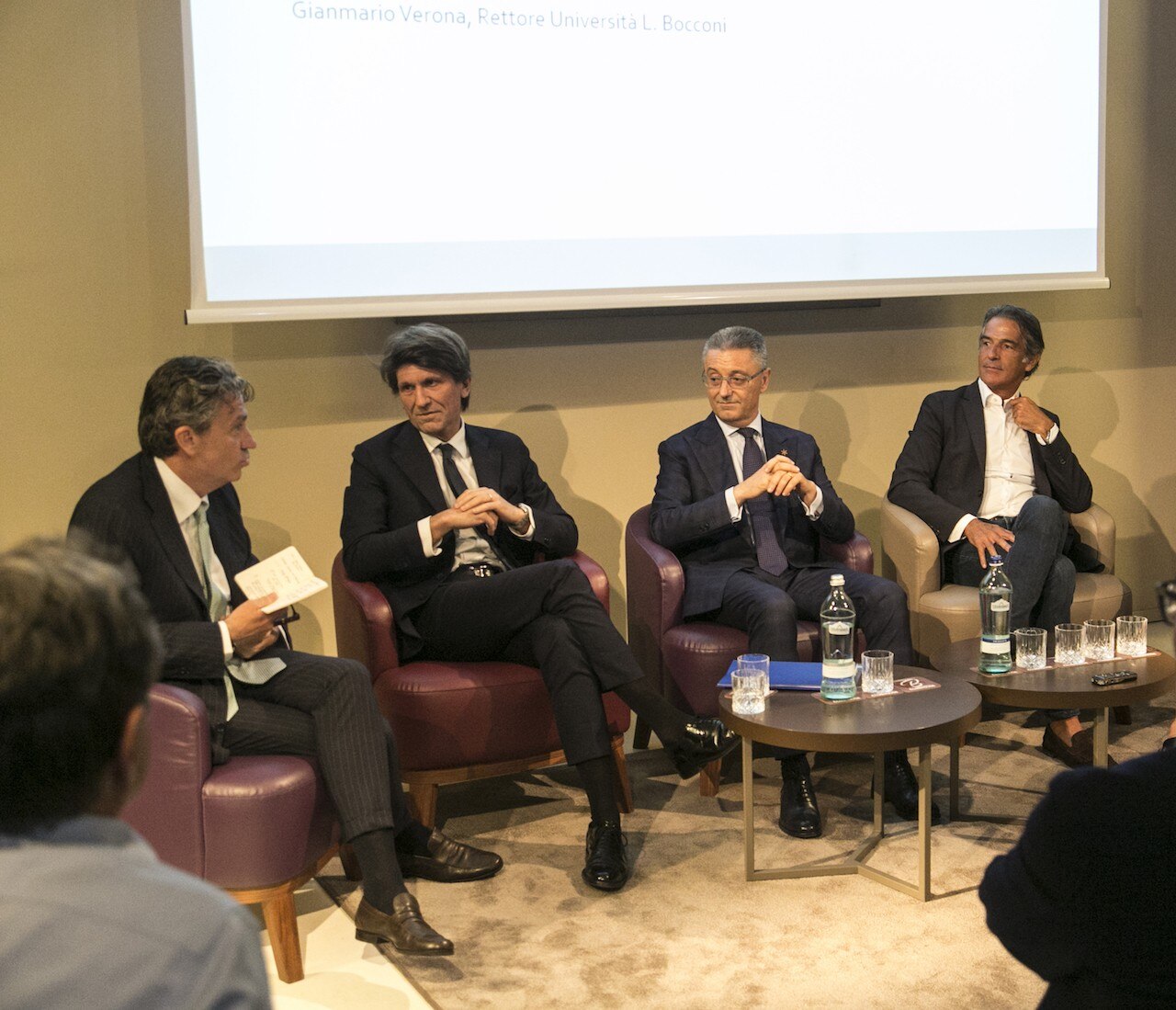This article was originally published on Domus 1038, September 2019
Advertorial by Bain & Company and EXS
The study by Bain & Company
While the round table was the think-tank of the DesignLab event, the research conducted by Bain and Company formed its indispensable prologue, which in turn was based on an idea by Filippo Cesarino, the creator of this initiative. As the head of the design and luxury department at EXS Italia, he considers high-quality design to be of strategic value for Italy – not only for the slice of gross domestic product it represents, but also for being a vehicle of Italian style. Yet all too often, Italian companies lack the critical mass to compete on the international market. Many, distracted by a generational changing of the guards, are unable to apply the proper managerial techniques.
DesignLab was organised to offer stakeholders in the high-quality design business a meeting point where they can devise forms of collaboration to promote this vital sector.
The market research conducted by Bain and presented by Claudia D’Arpizio, head of global luxury goods practice, plotted out the sector to obtain a basis for the debate and suggest potential areas of action. The resulting picture shows moderate growth, slowed by the difficulty to penetrate new markets, especially China. In 2018 the world turnover in high-quality design was 36 billion euros, which is more or less the yearly turnover of Ikea. Of these 36 billion, 17 billion were generated by living room and bedroom products, 13 were almost equally split between kitchen and bathroom products, 4 were from lighting , and 2 billion came from outdoor furniture.
The 2009 downfall (minus 9 per cent) in the compound annual growth rate has been followed by a rebound, meaning that the great challenge regards the future. If growth continues to be a low single digit, the forecast is for the high-quality design market to reach 45 or 50 billion euros by 2025. But its potential is closer to 120 billion, according to Bain’s estimate.
Today’s consumers are motivated by post-aspirational logics connected to ideals and interests that have priority over actual material needs. In order to convince them to buy quality interior-design furnishings, it is necessary enter into synchrony with their value system
In the near future, the best-performing category will remain “living room and bedroom”, but increases are expected for lighting and outdoor furniture, too. Contract furnishings are a major contributor to the market’s vigour, thanks to a growing demand for experience-driven surroundings in homes, hotels, restaurants and especially airports, train stations, schools and hospitals – all places where good design is poised to play an increasingly important role.
The real game, however, will be played out on new markets that are generating fortunes in the automotive and luxury personal-goods industries. The latter sector grew by 50 per cent from 2005 to 2017 thanks to China.
How to distinguish the developing lifestyles of Asia’s newborn middle class and the nouveaux riches seems to form a particular challenge for the world’s high-quality design companies, the average of which grosses 80 million euros yearly, while in the luxury personal-goods sector that number rises to 600 million on average, with some companies turning over more than one billion. The small size of the high-quality-design sector is to blame on lack of investment in a distribution network in the Orient, and lack of investment in modern tools for sales and communications. This means e-commerce above all. But also augmented reality in shops and on social networks can function as a propulsive force to the public’s taste and a way to gauge it.
Today’s consumers are motivated by post-aspirational logics connected to ideals and interests that have priority over actual material needs. In order to convince them to buy quality interior-design furnishings, it is necessary enter into synchrony with their value system.
In order to tap the potential of the new markets, high-quality design manufacturers need to pursue a change of paradigm, even more than a change of marketing and sales strategies.

The round table
Is it possible for entrepreneurial vision and management to coexist within a “united design system”? In other words, can the manufacturers of high-quality design embrace the paradigm of the global competition by creating value without losing value? Even briefer: can we entrust ourselves to private equity without giving up creative independence?
These complex questions formed the basis of the round table moderated by the editorial director of Domus magazine, Walter Mariotti. The panel was made up of Paolo Colonna, chairman of Creazione di Valore with long-standing experience in private equity operations in Italy; Roberto Gavazzi, head of Boffi since 30 years and recently also head of De Padova and ADL Doors; Giovanni Del Vecchio, the CEO of Giorgetti; Claudio Feltrin, the president of Arper; Gianmario Verona, the dean of Bocconi University in Milan; and Claudia D’Arpizio, head of global luxury goods practice at Bain & Company.
The first speaker was Colonna. “The design sector is now global. There is no difference between Shanghai, Milan or New York, but it is almost impossible for small companies to be everywhere. They are by nature entrepreneurial and not proficient in managerial techniques. The use of private equity could be the right solution to create synergy and multiply strengths,” according to Paolo Colonna. His words were supported by Gavazzi, who thinks that “private equity is an extraordinary added value of our sector, because it brings capital and a whole series of stimuli to us entrepreneurs. But it must be said that it is still possible to grow on our own by following strategies that are longer-term but perhaps more in line with our DNA. These are two alternative models, both valid.”
Does this mean that it is possible for two worlds to coexist that by their very nature move at different speeds? Mariotti wants to know. “I’d say it’s more a question of timing than speed,” answers Colonna. “It is unthinkable for an investor to obtain favourable returns within the standard four-year investment horizon. This is why the formula of the ‘club deal’, which has no deadline, is more appropriate.”
Gavazzi brings a different viewpoint to the table, one that is entrepreneurial in the traditional sense of the word. “Private equity usually aims to aggregate similar but independent companies, meaning without a univocal identity. Instead, as an entrepreneur, I aim to create an ecosystem around a single nucleus of well-defined values, and then I reason in terms of decades. So before I acquire a new brand, I might wait several years or more.”
Another important subject is the training of dealers and consumers. Professor Verona says: “We are seeing an epochal renewal of industrial models. It is similar to what led to the birth of the first big multinationals 100 years ago. Thanks to digital technology and big data, everything is shifting downstream toward the user. This is a new element toward which companies have not yet opened up entirely. They tend to think that the central values are still a nice product and a great designer. Instead, the fundamental competency is bottom-up marketing that detects the wishes of clients and is able to build a communication strategy on an inductive basis.”
Giovanni Del Vecchio has a word to say about this. “I see three main lines of action. First of all, craftsmanship needs to be cultivated. It’s what continues to distinguish our manufacturers from mass production. Then, the distributors must be educated in the new markets, because it is no longer possible to place a product in a space. Rather we must create the space around the product. Lastly, we need to supply the consumer with the tools to understand our values, which is a more complicated point.”
What about the resources? Mariotti wants to know where they are. Giovanni Del Vecchio does not beat around the bush. “For a company with a turnover of less than 100 million, it is inconceivable to compete with colossuses like LVMH in the field of blockchain or augmented reality. Creating a network is strictly necessary, either by means of private equity or by means of strategic alliances. If you take private equity, however, it is important that the entrepreneur remain at the helm of the brand, because he is the one who represents, is familiar with, and preserves the company’s DNA.”
Nowadays, you need a complex system in which, for instance, the salesperson is fundamental. Well-made brochures and well-trodden trade shows are no longer enough. An attractive experience around the product must be created, a task that requires a lengthy and refined chain of work
Claudio Feltrin expresses a systemic thought. “We are experiencing a phase of change. There are great risks but also great opportunities. If you look closely, we have never had anything like the potential we are presented with today. But it is necessary to understand that the market in which the best producer beats the competition is finished. Nowadays, you need a complex system in which, for instance, the salesperson is fundamental. Well-made brochures and well-trodden trade shows are no longer enough. An attractive experience around the product must be created, a task that requires a lengthy and refined chain of work. You can discuss how to find the resources, but in the meantime let’s not forget to cultivate talent and preserve competencies.”
Claudia D’Arpizio has a few things to say on the subject of training, and her comments are to the point. “Asian consumers are evolving very rapidly concerning their taste and culture. In a very short while, they will be among the most sophisticated in the world. So it is our duty to export the contents of what is made in Italy in an efficient manner, for example by means of influencers, whom we seem to be excluding. Italianity still has much value, but we cannot waste time, because design is already global and intercultural. The big names are found worldwide. In a certain sense, high-quality design companies are being called upon to be cultural mediators.”
The round table comes to a close with the pointed observation of a special guest, Dario Rinero, the managing director of Poltrona Frau. “Unfortunately, the furniture sector has not succeeded in creating giant businesses like you see in fashion. We suffer from industrial dwarfism. As has already been underlined, we are still too attached to the old model of production and sales, which is now obsolete.”
What to do? “Seeing it has been ascertained that a quality product is a necessary but not sufficient condition today, there are two main actions to take,” concludes Rinero. “One, we must invest in communication, a field in which design companies spend only 1 per cent of their turnover compared to fashion’s 7 per cent. And two, it is vital that the country’s system of policies, the Italian Industrial Federation, and the associations succeed in creating one-billion-euro businesses. Let the seeds we have planted here today not go to waste.”
Opening picture: Alberto Tagliabue/courtesy of Giorgetti


